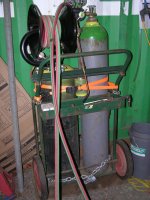Lotsa folks are confused about oxy/acetylene torches as opposed to oxy/fuel torches. So I will try to help explain. Oxy/acetylene flames burn very hot. Though not the hottest flame oxy/acetylene is pretty close to the hottest. This means that the flame can be used to melt steel, which is what you need to do if you are welding steel.
Common oxy/fuel flames, such as oxy/propane, don't burn as hot, so are not good for welding steel.
Though this seems wrong, common oxy/fuel flames have more heat energy than oxy/acetylene. So even though oxy/acetylene burns hotter that oxy/propane, the flame itself, when burning properly, is smaller, and so delivers less actual calories of heat into the work. The upshot is the different flames are better for different jobs.
Most of the time when really concentrated heat is needed oxy/acetylene is the best choice. When cutting steel though oxy/fuel is the better choice. This is because the torch flame only pre-heats the work enough for the oxygen to start burning with the steel. Oxy/fuel steel cutting is an exothermic process. This means that the oxygen reacts with the steel and produces heat. The reaction is fast enough that the steel melts, and some actually burns.
Oxy/fuel is also usually plenty hot enough for brazing and silver soldering. And air/acetylene, like that big tank and torch shown, is great for soldering copper pipe. Once again the acetylene flame has enough concentrated heat to get the job done better than air/fuel.
When soldering, whether soft soldering like plumbing stuff, or hard soldering, commonly known as silver soldering, it is vitally important to heat the work fast. This is because the flux is absorbing oxygen and so keeping the oxygen from contaminating the solder joint. But the flux can only absorb so much oxygen and the longer it takes to melt the solder the more oxygen the flux needs to absorb. If it takes too long to heat the joint the flux will absorb all the oxygen it can and the solder and the parent metal will start to oxidize and the solder will not wet the metal and will not flow. Air/acetylene torches will heat the copper pipe so fast that the copper doesn't have time to wick away the heat before the joint comes up to temperature. So soldering copper pipe with air/acetylene is much easier than using air/propane or air/MAPP.
I know the above explanation is brief and a lot of info is not included but I did cover the basics. So you need to decide if you need the tiny oxy/acetylene set. If you plan on doing any copper pipe plumbing requiring soldering then you should keep the larger tank and torch combo. It is way better than using propane or Mapp gas.
All the tanks shown are owner tanks. If they need to be re-filled most places will just exchange them, they won't re-fill yours and then give them back to you. If the tanks are out of date then you may need to pay a charge for them to be tested. In any case there is no benefit to having your particular tanks re-filled, exchanging them for a full tank is fine.
Eric
